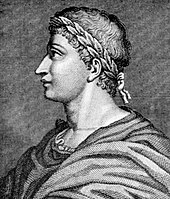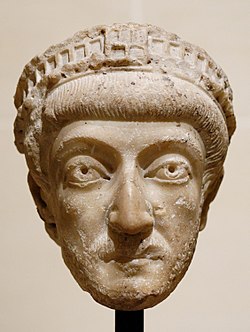|
Theodosius II – Roman Emperor: 408-450 A.D. –
Bronze AE4 11mm (0.73 grams) Cyzicus mint: 425-435 A.D.
Reference: RIC 451 (X, Theodosius II)
DNTHEODOSIVSPFAVG – Diademed, draped and cuirassed bust right.
No legend Exe: SMKΔ – Wreath, cross within.
You are bidding on the exact item pictured,
provided with a Certificate of Authenticity and Lifetime Guarantee of
Authenticity.
A laurel wreath is a circular
wreath
made of interlocking branches and leaves
of the
bay laurel
(Laurus nobilis), an aromatic
broadleaf evergreen, or later from spineless butcher’s broom (Ruscus
hypoglossum) or cherry laurel (Prunus
laurocerasus). In
Greek mythology
,
Apollo
is represented wearing a laurel wreath
on his head. In
ancient Greece
wreaths were awarded to victors,
both in athletic competitions, including the ancient
Olympics
made of wild olive-tree know n n
as “kotinos“
(κότινος),[1]
(sc. at
Olympia
) and in poetic meets; in
Rome
they were symbols of martial victory,
crowning a successful commander during his
triumph
. Whereas ancient laurel wreaths are
most often depicted as a
horseshoe
shape, modern versions are usually
complete rings.
In common modern idiomatic
usage it refers to a victory. The
expression “resting on one’s laurels” refers to someone relying entirely on
long-past successes for continued fame or recognition, where to “look to one’s
laurels” means to be careful of losing rank to competition.
Academic use

Ovid
with laurel wreath, common in
poets.
In some countries the laurel wreath is used as symbol of the
master’s degree
. The wreath is given to young
masters in the
graduation ceremony
of the university. The word
“Laureate”
in ‘poet
laureate‘ refers to being signified by the laurel wreath. The
medieval Florentine poet and philosopher
Dante Alighieri
,[dubious
–
discuss
] a graduate of the
Sicilian School
, is often represented in
paintings and sculpture wearing a laurel wreath.
Laureato[3]
is the term used in Italy
to refer to any graduated student. In
some italian regions (Veneto,
Friuli-Venezia Giulia
and
Trentino
), right after the graduation ceremony
(in Italian: laurea), the student receives a laurel wreath and is allowed
to wear it for the rest of the day. This tradition was born in the
University of Padua
and since the end of the
19th century is common to all
northeastern Italian
universities.
At
Connecticut College
in the United States,
members of the junior class carry a laurel
chain
, which the seniors pass through during
commencement. It represents nature and the continuation of life from year to
year. Immediately following commencement, the junior girls write out with the
laurels their class year, symbolizing they have officially become seniors and
the cycle will repeat itself the following spring.
At
Mount Holyoke College
in
South Hadley, Massachusetts
, United States,
laurel has been a fixture of
commencement
traditions since 1900, when
graduating students carried or wore laurel wreaths. In 1902, the chain of
mountain laurel
was introduced; since then,
tradition has been for seniors to march across campus, carrying and linked by
the chain. The mountain laurel represents the
bay laurel
used by the
Romans
in wreaths and crowns of honor.
At Reed College
in
Portland, Oregon
, United States, members of the
senior class receive laurel wreaths upon submitting their senior
thesis
in May. The tradition stems from the use
of laurel wreaths in athletic competitions; the seniors have “crossed the finish
line,” so to speak.
At
St. Mark’s School
in
Southborough, Massachusetts
, students who
successfully complete three years of one classical language and two of the other
earn the distinction of the Classics Diploma and the honor of wearing a laurel
wreath on Prize Day.
In Sweden
, those receiving a Doctorate or an
Honorary Doctorate
at the Faculty of Philosophy
(meaning Philosophy, Languages, Arts, History and Social Sciences), receive a
laurel wreath during the ceremony of conferral of the degree.
Architectural and decorative arts motif

“Victory, A Knight Being Crowned With A Laurel Wreath” by
Frank Dicksee
.
The laurel wreath is a common motif in
architecture
,
furniture
, and
textiles
. The laurel wreath is seen carved in
the stone and decorative plaster works of
Robert Adam
, and in
Federal
,
Regency
,
Directoire
, and
Beaux-Arts
periods of architecture. In
decorative arts, especially during the
Empire period
, the laurel wreath is seen woven
in textiles, inlaid in marquetry, and applied to furniture in the form of gilded
brass mounts.
Alfa Romeo
added a laurel wreath to their
logo after they won the inaugural Automobile World Championship in
1925 with the
P2
racing car.
 Theodosius Theodosius
II (10
April 401
–
July 28
,
450), called
the
Calligrapher
, was a
Eastern Roman Emperor
(408-450). He is mostly known for promulgating the
Theodosian law code
as well for the
Theodosian Walls of Constantinople
. He also presided over the outbreak of
two great christological controversies
.
Setting a record for longest-reigning Roman emperor
at 48 years (equivalent to a dozen U.S. Presidential terms!), Theodosius
II set remarkably few other records in all this time. He was the last
emperor to rule both east and west halves, albeit briefly, after the
death of Honorius and before the puppet emperor Johannes came onto the
scene. As for his own achievements, he wasn’t much more than a
figurehead esconced in his palace. His sister Pulcheria took the active
role in steering the empire. He died a few days after a hunting
accident.
Life
Theodosius was born in 401 as the only son of Emperor
Arcadius
and his Frankish-born wife
Aelia
Eudoxia
. In 408, his father died and the seven-year-old boy became Emperor
of the Eastern parts of the Roman Empire.
Government was at first by the
Praetorian Prefect
Anthemius
, under whose supervision that the
Theodosian land walls
of Constantinople were constructed.
In 414, Theodosius’ older sister
Pulcheria
was proclaimed Augusta and assumed the regency. By 416 Theodosius was capable of
ruling himself, but his sister remained a strong influence on him. She also
assisted her brother in procuring marriage to the Athenian
Aelia
Eudocia
in June 421. The two had a daughter named
Licinia Eudoxia
.
Theodosius’ increasing interest in Christianity, fuelled by
the influence of Pulcheria, had him start a
war against the Sassanids
(421-422), who were persecuting Christians; the
war ended in a draw, when the Romans were forced to accept peace as the Huns
menaced
Constantinople
.[1]
In 423, the Western Emperor
Honorius
, Theodosius’ uncle, died and the
primicerius notariorum
Joannes
was
proclaimed Emperor. Honorius’ sister
Galla Placidia
and her young son
Valentinian
fled to Constantinople to seek Eastern assistance and after some
deliberation in 424 Theodosius opened the war against Joannes. In May 425,
Valentinian III was installed as Emperor of the West, with his mother acting as
regent. To strengthen the ties between the two parts of the Empire, Theodosius’
daughter
Licinia Eudoxia
was betrothed to Valentinian.
University
and Law Code
In 425, Theodosius founded the
University of Constantinople
with 31 chairs (15 in Latin and 16 in Greek).
Among subjects were law, philosophy, medicine, arithmetic, geometry, astronomy,
music and rhetoric.
In 429, Theodosius appointed a commission to collect all of
the laws since the reign of
Constantine I
, and create a fully formalized system of law. This plan was
left unfinished, but the work of a second commission that met in Constantinople,
assigned to collect all of the general legislations and bring them up to date
was completed, and their collection published as the
Codex Theodosianus
in 438. The law code of Theodosius II, summarizing
edicts promulgated since Constantine, formed a basis for the law code of Emperor
Justinian
I
in the following century.
Wars
with the Huns, Vandals and Persians
The Eastern Empire was also plagued by short raiding attacks
by the Huns
. The
Huns arrived at
Athyra (Büyükçekmece)
in 447, but an agreement was reached with the
Eastern Roman empire
, negotiated by
Anatolius
. The Emperor chose to pay tribute which amounted to 350 Roman
pounds (ca. 114.5 kg) of gold until 435 and 700 Roman pounds after that.
When Roman Africa fell to the Vandals in 439, both Eastern
and Western Emperors sent forces to
Sicily
, to
launch an attack at the Vandals at Carthage, but this project failed. Seeing the
imperial borders without significant forces, the
Huns and
Sassanid Persia
declared war. During 443 two Roman armies were defeated and
destroyed by the Huns. In the subsequent peace agreement Roman tribute was
tripled to 2,100 Roman pounds (ca. 687 kg) in gold after which the Huns withdrew
into the interior of their empire. The
war with Persia
on the other hand proved indecisive, and a peace was
arranged in 422 without changes to the status quo.
Theological
disputes
During a visit to Syria, Theodosius met the preacher
Nestorius
and appointed him Patriarch of Constantinople in 428. Nestorius quickly became
involved in the disputes of two theological factions, which differed in their
Christology
. Nestorius tried to find a middle ground between those that,
emphasizing the fact that in Christ God had been born as a man, insisted on
calling
the Virgin Mary
Theotokos (“birth-giver of God”), and those that
rejected that title because God as an eternal being could not have been born.
Nestorius suggested the title Christotokos (“birth-giver to Christ”), but
did not find acceptance by either faction and was accused of detaching Christ’s
divine and human natures from each other, a heresy later called
Nestorianism
. Though initially supported by the Emperor, Nestorius found a
forceful opponent in Patriarch
Cyril of Alexandria
. With the consent of the Emperor and
Pope Celestine I
, an
Ecumenical Council convened in Ephesus
in 431, which affirmed the title
Theotokos and condemned Nestorius, who was then exiled by the Emperor.
Almost twenty years later, the theological dispute broke out
again, this time caused by the Constantinopolitan abbot
Eutyches
,
whose Christology was understood by some to mingle Christ’s divine and human
nature into one. Eutyches was condemned by Patriarch
Flavian of Constantinople
but found a powerful friend in Cyril’s successor
Dioscurus of Alexandria
.
Another council convoked to Ephesus
in 449, deemed “robber synod” because of
its tumultuous circumstances, restored Eutyches and deposed Flavian, who was
mistreated and died shortly afterwards.
Pope Leo I
of Rome and many other bishops protested against the outcome, but the Emperor
supported it. Only after his death in 450 would the decisions be reversed at the
Council of Chalcedon
.
Death
Theodosius died in 450 as the result of a riding accident. In
the ensuing power struggle, his sister
Pulcheria
,
who had recently returned to court, won out against the
eunuch
Chrysaphius
. She married the general
Marcian
,
thereby making him Emperor.
|





 n
n


 Theodosius
Theodosius 


